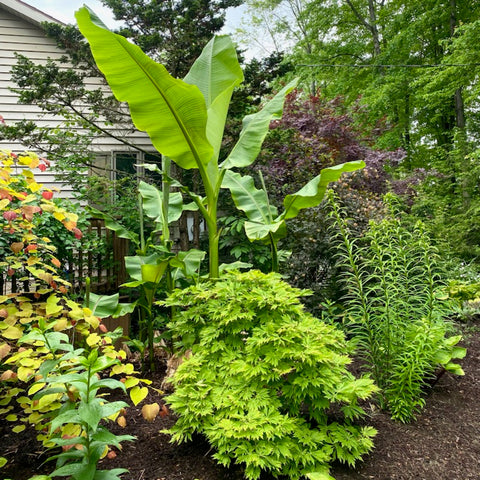 We’re celebrating CLEMATIS, the queen of climbers, at “Clematis Kerfluffle” on April 16-21 at Groovy Plants Ranch. The weekday event features food trucks and 1,000 premium clematis vines.]]>
We’re celebrating CLEMATIS, the queen of climbers, at “Clematis Kerfluffle” on April 16-21 at Groovy Plants Ranch. The weekday event features food trucks and 1,000 premium clematis vines.]]>

Clematis 'Taiga' (photo from Gardening Express)
Clematis Background
Clematis is a Greek word which simply means a climbing plant. And, they definitely climb – some only two feet, most 5-8 feet and others up to 30 feet! In North America, we usually say clem-AT-is, yet in England, you’re more likely to hear CLEM-uh-tis. There are several hundred clematis species world-wide, and their variety is impressive.
“Lots of gardeners grow the classic purple ‘Jackmanni,’ and we want to show them there are so many more cool climbers in a kaleidoscope of colors, sizes and forms -- even some repeat blooms,” says Jared. “They’re the perfect plant to grow up a trellis in a large or small garden, in a container or over a wall or tree stump.”
Here in the Midwest, dozens of clematis are cold hardy (Zones 4-9). Some clematis vines linger through winter temperatures, while others die back to the ground after a hard freeze and return each spring. Flower sizes range from two inches to 10 inches, and single blooms are the most common. As flowers
age, their outer petals fall away revealing a central pom-pom. Beyond singles, there are also double and bell-shaped blooms. Pollinators are drawn to clematis for their showy colors, abundance of flowers, and copious amounts of pollen and nectar.

Growing Clematis
Proper planting is a key to a clematis’s success. First, select a mature plant that’s hardy for your growing zone. Most prefer a sunny location with moist, well-drained soil. Dig a hole six inches deeper than the depth of the pot. Place the plant in the hole and gently bury the first six inches of growth taking care not
to break the stems.
Water well twice a week for the first six weeks. After that, water once a week if its dry. Clematis prefer “cool feet and sunny shoulders,” so try shading the base with other plants like hostas or daylilies and adding a layer of mulch especially when planting clematis along a hot, reflective west- or south-facing wall.
Supporting Clematis
Most clematis vines climb by wrapping their short leaf stems (petioles) around a narrow support that’s ¾-inch at most in diameter. For wider supports, add a few “helper lines” of twine or fishing line to get them started. Some of our favorite supports include a wall trellis, a tripod of bamboo poles (or cedar stakes) in a perennial border, and an obelisk in a container. Shorter clematis varieties like ‘Rouge Cardinal’ and ‘Pink Fantasy’ can be grown in containers year after year. Just make sure pots are at least 18 to 20 inches in diameter, and overwinter the potted plants in an unheated garage until mid-April.

Design Tips
Beyond a trellis, allow clematis vines to climb over a ledge, up a lamp post, through a tree or arborvitae and even ramble as groundcover.
“Clematis can add surprising color to a shrub rose, conifer or tree by planting one at the base,” says Jared. “Imagine a ‘Sweet Autumn’ clematis vine climbing up an older crabapple tree for a magical second round of blooms.”
Pruning
The “ponytail cut” is the simplest pruning technique and works well for most Midwestern clematis varieties. In late winter or early spring, grab a handful of growth and chop off 6 to 9 inches above soil level. The pruning will encourage fuller new growth. Some double varieties need special care, and other varieties can become top heavy with blooms if left unpruned. For more pruning details, visit the International Clematis Society’s pruning guide.

Unique Varieties
- Repeat and continuous bloomers: Varieties like ‘Vancouver Sea Breeze’ and ‘Toki’ will bloom in early spring, take a break in the heat of the summer and return with more blooms into the fall.
- Double bloomers: For extravagant blooms, try ‘Taiga’ with two-tone flowers in purple and cream or ‘Piilu’ with two-tone pink ruffled flowers.
- Color changers: Try ‘Arabella’ with flowers that open violet-blue then develop mauve centers and fade to soft blue with age.
- Plate-sized bloomer: ‘The First Lady’ features impressive blooms up to 10”.
- Cut flowers: Several varieties, like ‘Dr. Ruppel’ in lavender pink, make great cut flowers. Either cut long stems for a vase or float blooms in a bowl of water.
- Dwarf vines: A few dwarf varieties grow into a small shrub with bell-shaped flowers. Try ‘Stand By Me’ in blue, ‘Little Lemons’ in yellow, ‘Rebecca’ in red or ‘Acropolis’ in hot pink.
- Shade varieties: While most prefer sun, a few varieties like ‘Silver Moon’ and ‘Claire de Lune’ are adapted for part shade.
- Fragrant favorites: A handful of varieties are known for their scent. Try ‘Fair Rosamund,’ ‘Vancouver Fragrant Star,’ and ‘Capitaine Thuilleaux.’
]]>















































































































